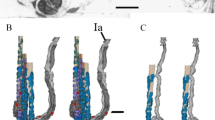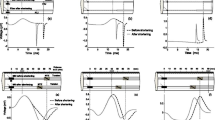Summary
The activities of human muscle spindle primary endings were recorded in the lateral peroneal nerve using the microneurographic method. The aim of the study was to test whether voluntary isometric contraction causes any after-effects, first in the resting discharge of muscle spindle primary endings and secondly in their responses to a slow ramp stretch. To investigate the latter point, the initial angular position of the ankle was passively adjusted until the unit fell silent, in order to introduce a delay in the responses to muscle stretch. The results were as follows: (1) most of the units did not exhibit the “post-contraction sensory discharge” reported to occur in numerous animal experiments; this means that the muscle spindle resting discharge was essentially the same before and after isometric voluntary contraction. (2) Isometric voluntary contraction led to changes in muscle spindle stretch sensitivity which resulted in a reduction in the stretch threshold and a decrease in the muscle spindle dynamic sensitivity. These data suggest that the after-effects observed may have been triggered by static fusimotor neurones. The results are discussed with reference to the theory according to which the processing by the CNS of muscular proprioceptive messages deals mainly with signals arising from muscles stretched during movement, and it is concluded that the coactivation of α and y motoneurones during the contraction facilitates the coding of the parameters of forthcoming stretching movements, by the muscle spindles.
Similar content being viewed by others
References
Capaday C, Cooke JD (1981) The effects of muscle vibration on the attainment of intended final position during voluntary human arm movements. Exp Brain Res 42: 228–230
Capaday C, Cooke JD (1983) Vibration-induced changes in movement-related EMG activity in humans. Exp Brain Res 52: 139–146
Crowe A, Matthews PBC (1964) The effects of stimulation of static and dynamic fusimotor fibres on the response to stretching of primary endings of muscle spindles. J Physiol 174: 109–131
Decandia M, Schieppati M, Crenna P (1978) Changes in the pause in muscle spindle discharge during a sequence of twitches. Exp Neurol 60: 201–212
Edin BB, Vallbo AB (1988) Stretch sensitization of human muscle spindles. J Physiol 400: 101–111
Emonet-Dénand F, Hunt CC, Laporte Y (1985a) Fusimotor aftereffects on responses of primary endings to test dynamic stimuli in cat muscle spindles. J Physiol 360: 187–200
Emonet-Dénand F, Hunt CC, Laporte Y (1985b) Effects of stretch on dynamic fusimotor after-effects in cat muscle spindles. J Physiol 360: 201–213
Enoka RM, Hutton RS, Eldred E. (1980) Changes in excitability of tendon tap and Hoffmann reflexes following voluntary contractions. Electroencephalogr Clin Neurophysiol 48: 664–672
Goodwin GM, McCloskey DI, Matthews PBC (1972) The contribution of muscle afferents to kinaesthesia shown by vibration induced illusions of movement and by the effects of paralysing joint afferents. Brain 95: 705–748
Gregory JE, Morgan DL, Proske U (1986) Aftereffects in the responses of cat muscle spindles. J Neurophysiol 56: 451–461
Gregory JE, Morgan DL, Proske U (1987) Changes in size of the reflex of cat and man attributed to aftereffects in muscle spindles. J Neurophysiol 58: 628–640
Gregory JE, Morgan DL, Proske U (1988) Aftereffects in the responses of cat muscle spindles and errors of limb position sense in man. J Neurophysiol 59: 1220–1230
Gregory JE, Mark RF, Morgan DL, Patak A, Polus B, Proske U (1990) Effects of muscle history on the stretch reflex in cat and man. J Physiol 424: 93–107
Hagbarth KE, Vallbo AB (1968) Discharge characteristics of human muscle afferents during muscle stretch and contraction. Exp Neurol 22: 674–694
Hagbarth KE, Hägglund JV, Nordin M, Wallin EU (1985) Thixotropic behaviour of human finger flexor muscles with accompanying changes in spindle and reflex responses to stretch. J Physiol 368: 323–342
Hutton RS, Suzuki S (1979) Postcontraction discharge of motor neurons in spinal animals. Exp Neurol 64: 567–578
Hutton RS, Smith JL, Eldred E (1973) Postcontraction sensory discharge from muscle and its source. J Neurophysiol 36: 1090–1103
Inglis JT, Frank JS (1990) The effect of agonist/antagonist muscle vibration on human position sense. Exp Brain Res 81: 573–580
Matthews PBC (1982) Where does sherrington's “muscular sense” originate? Muscles, joints, corollary discharges? Ann Rev Neurosci 5: 189–218
McCloskey DI (1978) Kinesthetic sensibility. Physiol Rev 58: 763–820
Morgan DL, Prochazka A, Proske U (1984) The after-effects of stretch and fusimotor stimulation on the responses of primary endings of cat muscle spindles. J Physiol 356: 465–477
Proske U, Morgan DL (1985) After-effects of stretch on the responses of cat soleus muscle spindles to static fusimotor stimulation. Exp Brain Res 59: 166–170
Ribot E, Roll JP, Vedel JP (1986) Efferent discharges recorded from single skeletomotor and fusimotor fibres in man. J Physiol 375: 251–268
Roll JP, Gilhodes JC, Tardy-Gervet MF (1980) Effets perceptifs et moteurs des vibrations musculaires chez l'homme normal: mise en évidence d'une réponse des muscles antagonistes. Arch Ital Biol 118: 51–71
Roll JP, Vedel JP (1982) Kinesthetic role of muscle afferents in man studied by tendon vibration and microneurography. Exp Brain Res 47: 177–190
Smith JL, Hutton RS, Eldred E (1974) Postcontraction changes in sensitivity of muscle afferents to static and dynamic stretch. Brain Res 78: 193–202
Vallbo AB (1974) Human muscle spindle discharge during isometric voluntary contractions: amplitude relation between spindle frequency and torque. Acta Physiol Scand 90: 319–336
Author information
Authors and Affiliations
Rights and permissions
About this article
Cite this article
Ribot-Ciscar, E., Tardy-Gervet, M.F., Vedel, J.P. et al. Post-contraction changes in human muscle spindle resting discharge and stretch sensitivity. Exp Brain Res 86, 673–678 (1991). https://doi.org/10.1007/BF00230541
Received:
Accepted:
Issue Date:
DOI: https://doi.org/10.1007/BF00230541




